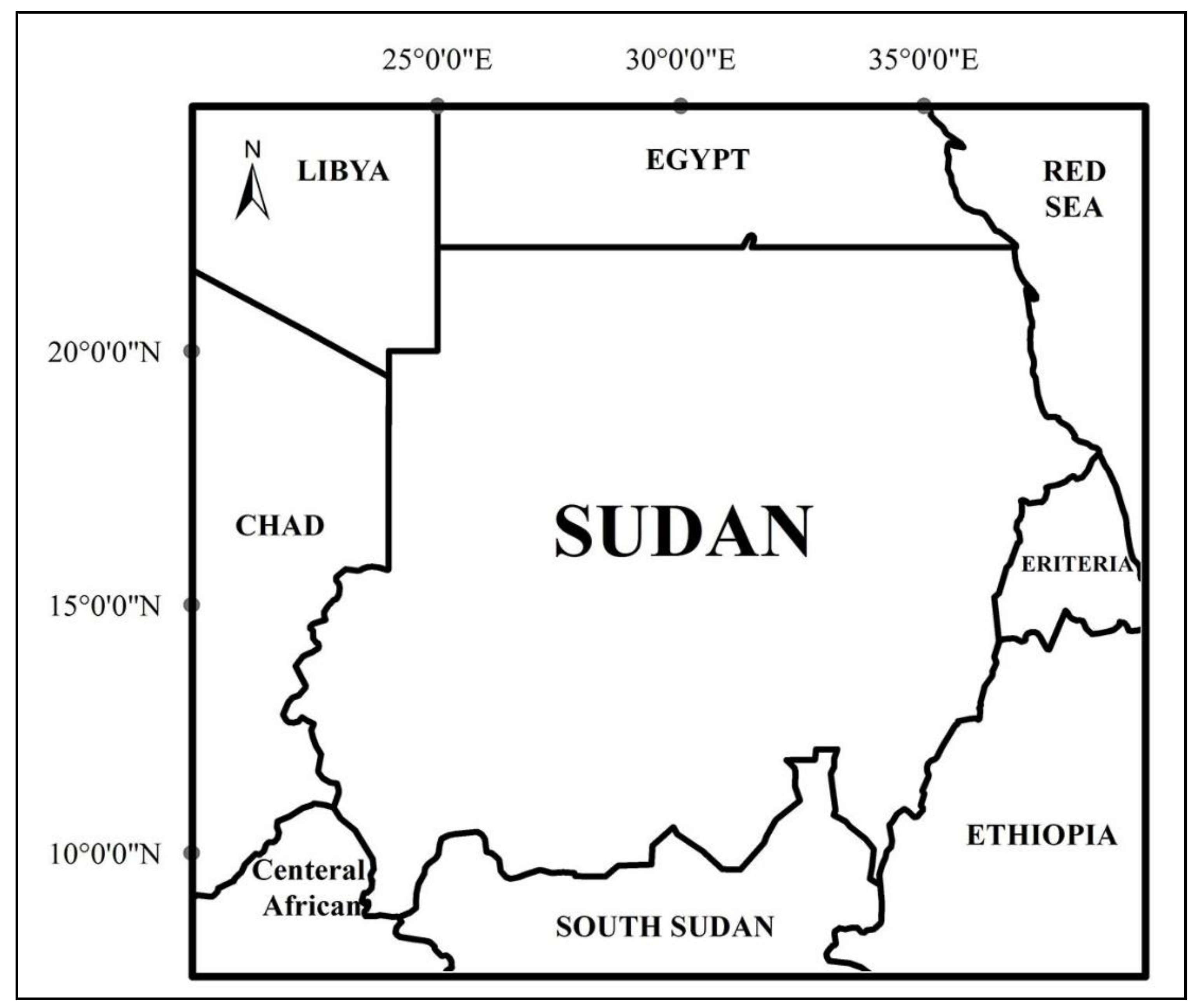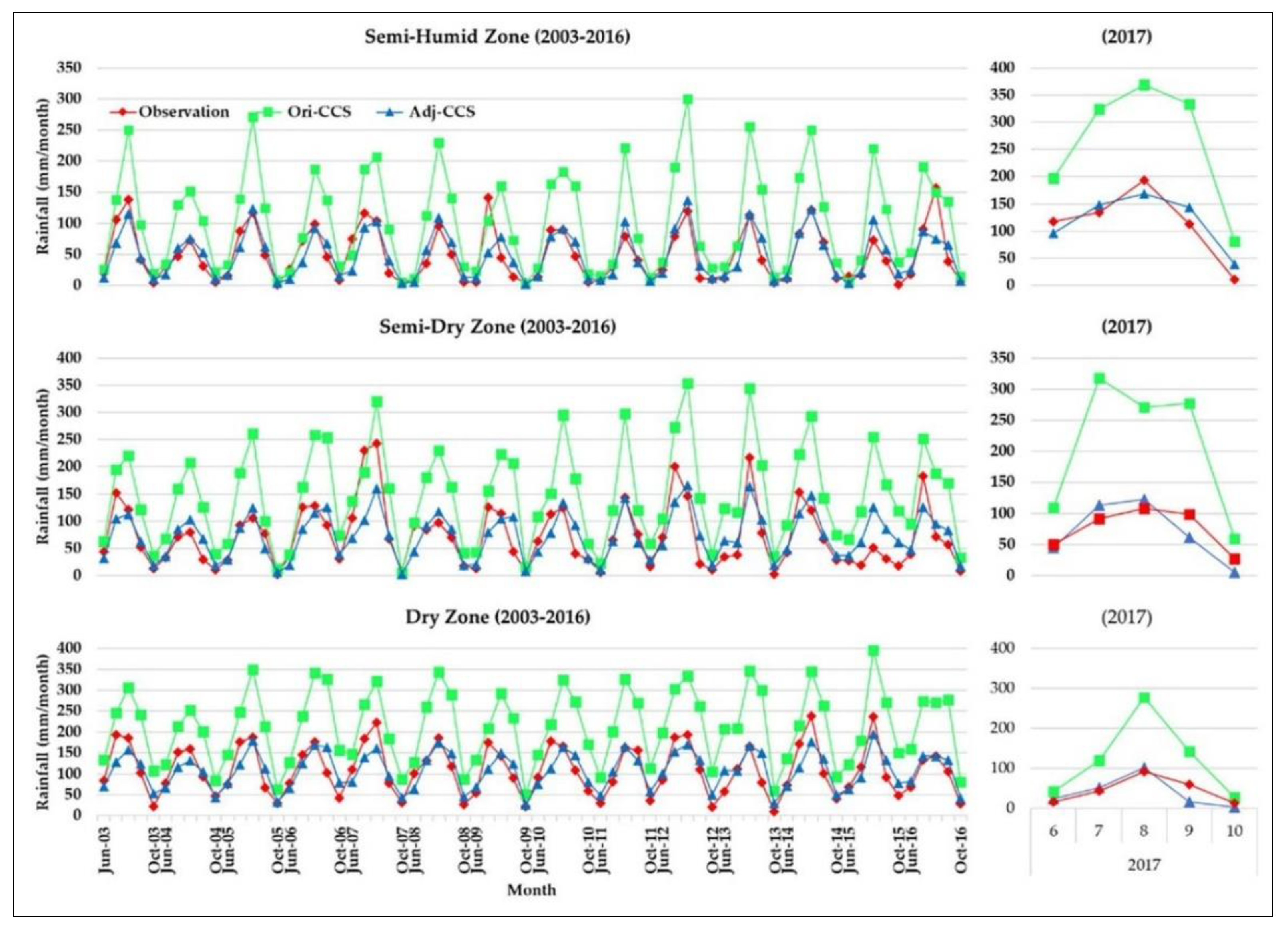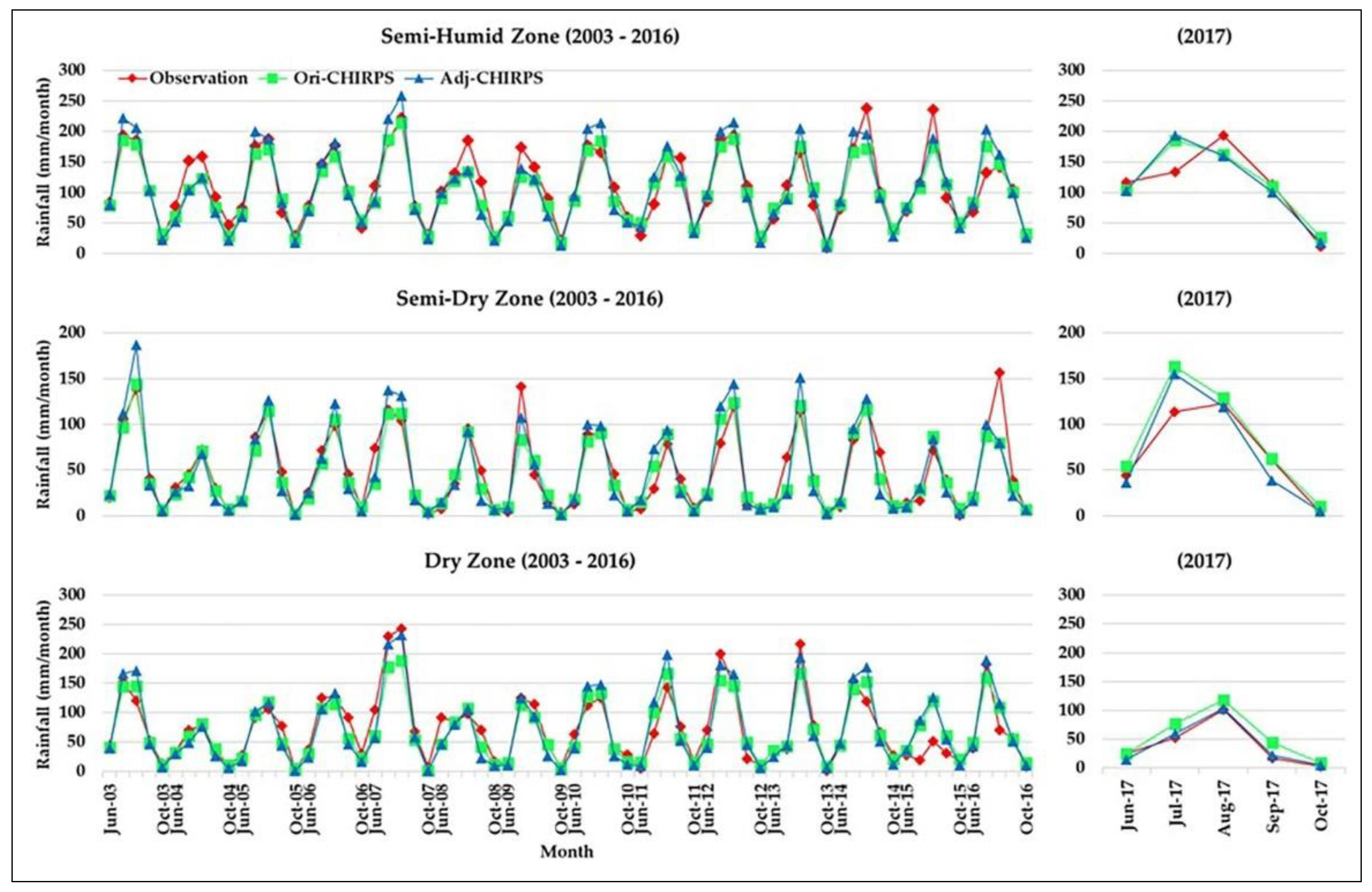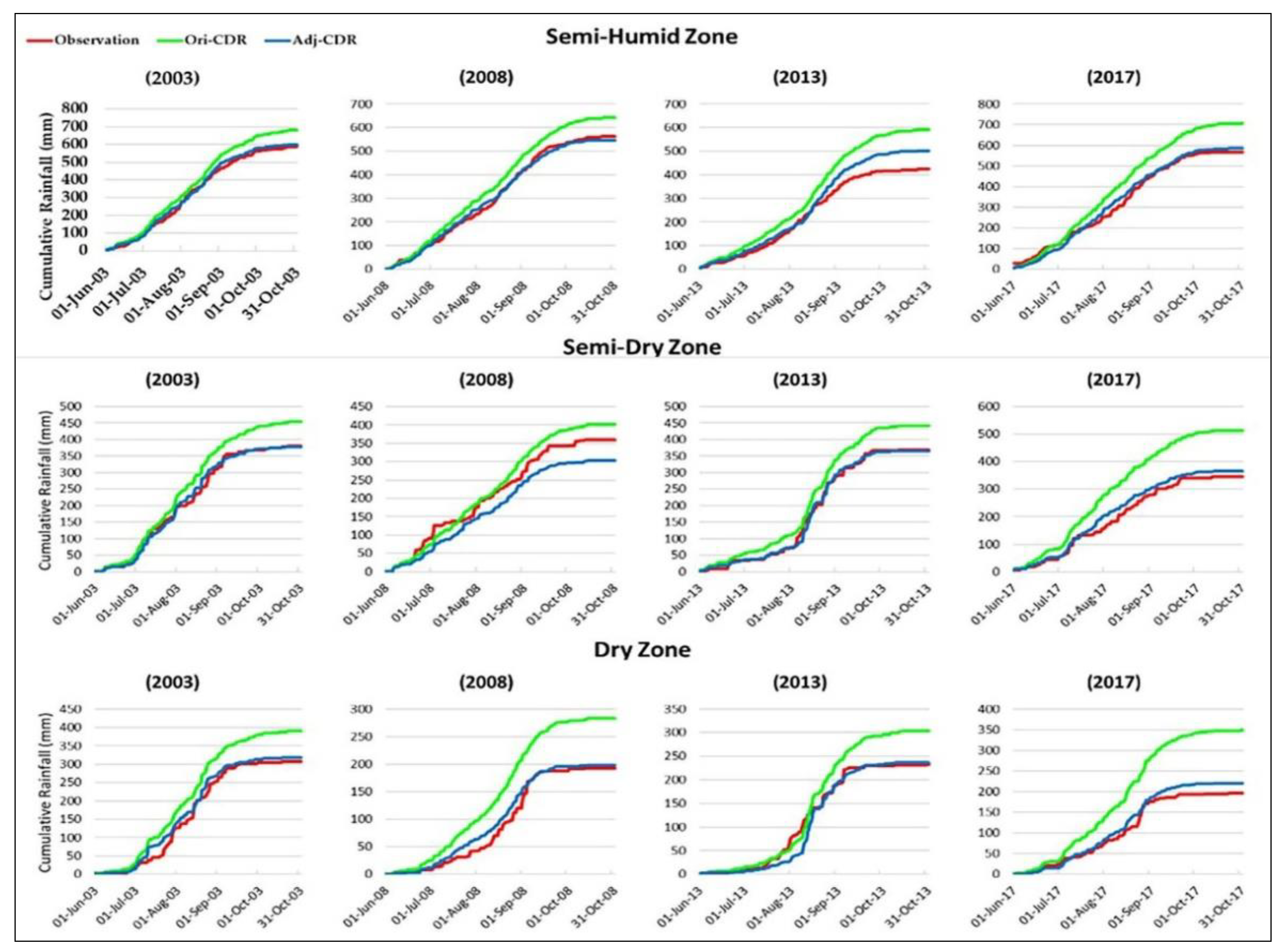Bias Adjustment of Four Satellite-Based Rainfall Products Using Ground-Based Measurements over Sudan
Abstract
:1. Introduction
2. Materials and Methods
2.1. Study Area
2.2. Datasets
2.2.1. Historical Data
2.2.2. Satellite-Based Estimation
| Satellite Product | Temporal Coverage | Spatial Coverage | Spatial Resolution | Temporal Resolution | Reference |
|---|---|---|---|---|---|
| PERSIANN-CCS | 2003–present | 60° S–60° N | 0.04° × 0.04° | Daily | [45] |
| PERSIANN-CDR | 1983–present | 60° S–60° N | 0.25° × 0.25° | Daily | [46] |
| CHIRPS Version 2.0 | 1981–present | 50° S–50° N | 0.05° × 0.05° | Daily | [47] |
| GPCP-1DD | 1996–present | 90° S–90° N | 01° × 01° | Daily | [20] |
2.3. Methodology
2.3.1. Quantile Mapping
- Empirical quantiles (QUANT): This method estimates the empirical CDF values of the time series observed and modeled with regularly spaced quantiles [49].
- Robust empirical quantiles (RQUANT): This method employs linear squares regression to estimate the quantile–quantile relationship’s values for time series with regularly spaced quantiles [50].
- Smoothing splines (SSPLIN): The quantile–quantile plot of the observed and modeled time series is fitted with a smoothing spline in this method [51].
2.3.2. Bias Correction of Satellite-Based Rainfall Estimates
2.3.3. Evaluation
3. Results and Discussion
3.1. Monthly Time Series
3.2. Daily Time Series
4. Conclusions
Author Contributions
Funding
Institutional Review Board Statement
Informed Consent Statement
Data Availability Statement
Acknowledgments
Conflicts of Interest
Abbreviations
| SREs | Satellite-based Rainfall Estimates |
| PERSIANN-CCS | Artificial Neural Networks–Cloud Classification System |
| PERSIANN-CDR | Artificial Neural Networks- |
| CHIRPS | Climate Hazards Group InfraRed Precipitation with Station data |
| GPCP | Global Precipitation Climatology Project |
| QM | Quantile Mapping |
| CZs | Climatic Zones |
| CDF | Cumulative Distribution Function |
| SNMD | Sudan National Meteorological Department |
| CHRS | Center for Hydrometeorology and Remote Sensing |
| ISCCP | International Satellite Cloud Climatology Project |
| USGS | United States Geological Survey |
| UCSB | University of California, Santa Barbara |
| RMSEs | Root Mean Square Errors |
| Ori-CCS | Original Cloud Classification System |
| Ori-CDR | Original Climate Data Record |
| Ori-CHIRPS | Original Climate Hazards Group InfraRed Precipitation with Station data |
| Ori-GCPC | Original Global Precipitation Climatology Project |
| Adj-CCS | Adjustment Cloud Classification System |
| Adj-CDR | Adjustment Climate Data Record |
| Adj-CHIRPS | Adjustment Climate Hazards Group InfraRed Precipitation with Station data |
| Adj-GCPC | Adjustment Global Precipitation Climatology Project |
| MB | Mean Bias |
| CORR | Correlation Coefficient |
References
- Maliva, R.; Missimer, T. [Environmental Science and Engineering] Arid Lands Water Evaluation and Management; Springer: Berlin/Heidelberg, Germany, 2012. [Google Scholar] [CrossRef]
- Sultana, R.; Nasrollahi, N. Evaluation of Remote Sensing Precipitation Estimates over Saudi Arabia. J. Arid. Environ. 2018, 151, 90–103. [Google Scholar] [CrossRef]
- Derin, Y.; Anagnostou, E.; Berne, A.; Borga, M.; Boudevillain, B.; Buytaert, W.; Chang, C.-H.; Delrieu, G.; Hong, Y.; Hsu, Y.C.; et al. Multiregional Satellite Precipitation Products Evaluation over Complex Terrain. J. Hydrometeorol. 2016, 17, 1817–1836. [Google Scholar] [CrossRef]
- Behrangi, A.; Khakbaz, B.; Jaw, T.C.; AghaKouchak, A.; Hsu, K.; Sorooshian, S. Hydrologic Evaluation of Satellite Precipitation Products over a Mid-Size Basin. J. Hydrol. 2011, 397, 225–237. [Google Scholar] [CrossRef] [Green Version]
- Fabry, F. Meteorological Value of Ground Target Measurements by Radar. J. Atmos. Oceanic Technol. 2004, 21, 560–573. [Google Scholar] [CrossRef]
- Sadeghi, M.; Nguyen, P.; Naeini, M.R.; Hsu, K.; Braithwaite, D.; Sorooshian, S. PERSIANN-CCS-CDR, a 3-Hourly 0.04° Global Precipitation Climate Data Record for Heavy Precipitation Studies. Sci. Data 2021, 8, 157. [Google Scholar] [CrossRef]
- Amorim, J.d.S.; Viola, M.R.; Junqueira, R.; Oliveira, V.A.d.; Mello, C.R. Evaluation of Satellite Precipitation Products for Hydrological Modeling in the Brazilian Cerrado Biome. Water 2020, 12, 2571. [Google Scholar] [CrossRef]
- Pang, J.; Zhang, H.; Xu, Q.; Wang, Y.; Wang, Y.; Zhang, O.; Hao, J. Hydrological Evaluation of Open-Access Precipitation Data Using SWAT at Multiple Temporal and Spatial Scales. Hydrol. Earth Syst. Sci. 2020, 24, 3603–3626. [Google Scholar] [CrossRef]
- Jiang, X.; Liu, Y.; Wu, Y.; Wang, G.; Zhang, X.; Meng, Q.; Gu, P.; Liu, T. Evaluation of the Performance of Multi-Source Precipitation Data in Southwest China. Water 2021, 13, 3200. [Google Scholar] [CrossRef]
- Huff, F.A. Sampling Errors in Measurement of Mean Precipitation. J. Appl. Meteorol. 1970, 9, 35–44. [Google Scholar] [CrossRef]
- Goovaerts, P. Geostatistics for Natural Resources Evaluation; Oxford University Press: Oxford, UK, 1997; ISBN 9780195115383. [Google Scholar] [CrossRef]
- Haberlandt, U. Geostatistical Interpolation of Hourly Precipitation from Rain Gauges and Radar for a Large-Scale Extreme Rainfall Event. J. Hydrol. 2007, 332, 144–157. [Google Scholar] [CrossRef]
- Wang, N.; Liu, W.; Sun, F.; Yao, Z.; Wang, H.; Liu, W. Evaluating Satellite-Based and Reanalysis Precipitation Datasets with Gauge-Observed Data and Hydrological Modeling in the Xihe River Basin, China. Atmos. Res. 2020, 234, 104746. [Google Scholar] [CrossRef]
- Goovaerts, P. Geostatistical Methodes for Incorporating Elevation into the Spatial Interpolation of Rainfall. J. Hydrol. 2000, 228, 113–129. [Google Scholar] [CrossRef]
- Boushaki, F.I.; Hsu, K.-L.; Sorooshian, S.; Park, G.-H.; Mahani, S.; Shi, W. Bias Adjustment of Satellite Precipitation Estimation Using Ground-Based Measurement: A Case Study Evaluation over the Southwestern United States. J. Hydrometeorol. 2009, 10, 1231–1242. [Google Scholar] [CrossRef]
- Pan, B.; Hsu, K.; AghaKouchak, A.; Sorooshian, S. Improving Precipitation Estimation Using Convolutional Neural Network. Water Resour. Res. 2019, 55, 2301–2321. [Google Scholar] [CrossRef] [Green Version]
- Sadeghi, M.; Asanjan, A.A.; Faridzad, M.; Nguyen, P.; Hsu, K.; Sorooshian, S.; Braithwaite, D. PERSIANN-CNN: Precipitation Estimation from Remotely Sensed Information Using Artificial Neural Networks–Convolutional Neural Networks. J. Hydrometeorol. 2019, 20, 2273–2289. [Google Scholar] [CrossRef]
- Zhao, B.; Dai, Q.; Zhuo, L.; Mao, J.; Zhu, S.; Han, D. Accounting for Satellite Rainfall Uncertainty in Rainfall-Triggered Landslide Forecasting. Geomorphology 2022, 398, 108051. [Google Scholar] [CrossRef]
- Hussein, K.A.; Alsumaiti, T.S.; Ghebreyesus, D.T.; Sharif, H.O.; Abdalati, W. High-Resolution Spatiotemporal Trend Analysis of Precipitation Using Satellite-Based Products over the United Arab Emirates. Water 2021, 13, 2376. [Google Scholar] [CrossRef]
- Huffman, G.J.; Adler, R.F.; Morrissey, M.M.; Bolvin, D.T.; Curtis, S.; Joyce, R.; McGavock, B.; Susskind, J. Global Precipitation at One-Degree Daily Resolution from Multisatellite Observations. J. Hydrometeor. 2001, 2, 36–50. [Google Scholar] [CrossRef] [Green Version]
- Sun, Q.; Miao, C.; Duan, Q.; Ashouri, H.; Sorooshian, S.; Hsu, K. A Review of Global Precipitation Data Sets: Data Sources, Estimation, and Intercomparisons. Rev. Geophys. 2018, 56, 79–107. [Google Scholar] [CrossRef] [Green Version]
- Behrangi, A.; Andreadis, K.; Fisher, J.B.; Turk, F.J.; Granger, S.; Painter, T.; Das, N. Satellite-Based Precipitation Estimation and Its Application for Streamflow Prediction over Mountainous Western US Basins. J. Appl. Meteorol. Climatol. 2014, 53, 2823–2842. [Google Scholar] [CrossRef] [Green Version]
- Thiemig, V.; Rojas, R.; Zambrano-Bigiarini, M.; De Roo, A. Hydrological Evaluation of Satellite-Based Rainfall Estimates over the Volta and Baro-Akobo Basin. J. Hydrol. 2013, 499, 324–338. [Google Scholar] [CrossRef]
- Gebregiorgis, A.S.; Tian, Y.; Peters-Lidard, C.D.; Hossain, F. Tracing Hydrologic Model Simulation Error as a Function of Satellite Rainfall Estimation Bias Components and Land Use and Land Cover Conditions: Tracing Hydrologic Model Simulation Error. Water Resour. Res. 2012, 48, 11. [Google Scholar] [CrossRef] [Green Version]
- Fang, G.H.; Yang, J.; Chen, Y.N.; Zammit, C. Comparing Bias Correction Methods in Downscaling Meteorological Variables for a Hydrologic Impact Study in an Arid Area in China. Hydrol. Earth Syst. Sci. 2015, 19, 2547–2559. [Google Scholar] [CrossRef] [Green Version]
- Rodrigues, D.T.; Santos e Silva, C.M.; dos Reis, J.S.; Palharini, R.S.A.; Cabral Junior, J.B.; da Silva, H.J.F.; Mutti, P.R.; Bezerra, B.G.; Goncalves, W.A. Evaluation of the Integrated Multi-SatellitE Retrievals for the Global Precipitation Measurement (IMERG) Product in the São Francisco Basin (Brazil). Water 2021, 13, 2714. [Google Scholar] [CrossRef]
- Lin, T.; Hu, L.; Guo, Z.; Qin, Y.; Yang, Z.; Zhang, G.; Zheng, M. Sources of Polycyclic Aromatic Hydrocarbons to Sediments of the Bohai and Yellow Seas in East Asia: Sources of Pahs to BS and YS Sediments. J. Geophys. Res. 2011, 116, 23305. [Google Scholar] [CrossRef]
- Tesfagiorgis, K.; Mahani, S.E.; Krakauer, N.Y.; Khanbilvardi, R. Bias Correction of Satellite Rainfall Estimates Using a Radar-Gauge Product—A Case Study in Oklahoma (USA). Hydrol. Earth Syst. Sci. 2011, 15, 2631–2647. [Google Scholar] [CrossRef] [Green Version]
- Seo, D.-J.; Breidenbach, J.P. Real-Time Correction of Spatially Nonuniform Bias in Radar Rainfall Data Using Rain Gauge Measurements. J. Hydrometeorol. 2002, 3, 93–111. [Google Scholar] [CrossRef] [Green Version]
- Smith, T.M.; Arkin, P.A.; Bates, J.J.; Huffman, G.J. Estimating Bias of Satellite-Based Precipitation Estimates. J. Hydrometeorol. 2006, 7, 841–856. [Google Scholar] [CrossRef]
- McCollum, J.R.; Krajewski, W.F.; Ferraro, R.R.; Ba, M.B. Evaluation of Biases of Satellite Rainfall Estimation Algorithms over the Continental United States. J. Appl. Meteorol. 2002, 41, 1065–1080. [Google Scholar] [CrossRef]
- Schmidli, J.; Frei, C.; Vidale, P.L. Downscaling from GCM Precipitation: A Benchmark for Dynamical and Statistical Downscaling Methods. Int. J. Climatol. 2006, 26, 679–689. [Google Scholar] [CrossRef]
- Chen, J.; Brissette, F.P.; Chaumont, D.; Braun, M. Finding Appropriate Bias Correction Methods in Downscaling Precipitation for Hydrologic Impact Studies over North America: Evaluation of Bias Correction Methods. Water Resour. Res. 2013, 49, 4187–4205. [Google Scholar] [CrossRef]
- van Steenbergen, E.F.; Ellemers, N. Is Managing the Work-Family Interface Worthwhile? Benefits for Employee Health and Performance. J. Organiz. Behav. 2009, 30, 617–642. [Google Scholar] [CrossRef]
- Themeßl, M.J.; Gobiet, A.; Heinrich, G. Empirical-Statistical Downscaling and Error Correction of Regional Climate Models and Its Impact on the Climate Change Signal. Clim. Chang. 2012, 112, 449–468. [Google Scholar] [CrossRef]
- Piani, C.; Weedon, G.P.; Best, M.; Gomes, S.M.; Viterbo, P.; Hagemann, S.; Haerter, J.O. Statistical Bias Correction of Global Simulated Daily Precipitation and Temperature for the Application of Hydrological Models. J. Hydrol. 2010, 395, 199–215. [Google Scholar] [CrossRef]
- Zhang, X.; Tang, Q. Combining Satellite Precipitation and Long-Term Ground Observations for Hydrological Monitoring in China: Satellite-Aided Hydrological Monitoring. J. Geophys. Res. Atmos. 2015, 120, 6426–6443. [Google Scholar] [CrossRef] [Green Version]
- Shen, Y.; Zhao, P.; Pan, Y.; Yu, J. A High Spatiotemporal Gauge-Satellite Merged Precipitation Analysis over China. J. Geophys. Res. Atmos. 2014, 119, 3063–3075. [Google Scholar] [CrossRef]
- Elagib, N.A.; Mansell, M.G. Recent Trends and Anomalies in Mean Seasonal and Annual Temperatures over Sudan. J. Arid. Environ. 2000, 45, 263–288. [Google Scholar] [CrossRef]
- Hong, Y.; Hsu, K.-L.; Sorooshian, S.; Gao, X. Precipitation Estimation from Remotely Sensed Imagery Using an Artificial Neural Network Cloud Classification System. J. Appl. Meteorol. 2004, 43, 1834–1853. [Google Scholar] [CrossRef] [Green Version]
- Hsu, K.; Gao, X.; Sorooshian, S.; Gupta, H.V. Precipitation Estimation from Remotely Sensed Information Using Artificial Neural Networks. J. Appl. Meteorol. 1997, 36, 1176–1190. [Google Scholar] [CrossRef]
- Funk, C.C.; Peterson, P.J.; Landsfeld, M.F.; Pedreros, D.H.; Verdin, J.P.; Rowland, J.D.; Romero, B.E.; Husak, G.J.; Michaelsen, J.C.; Verdin, A.P. A Quasi-Global Precipitation Time Series for Drought Monitoring; US Geological Survey Data Series; US Geological Survey: Reston, VA, USA, 2014. [Google Scholar] [CrossRef]
- Meadows, G.A.; Meadows, L.A.; Wood, W.L.; Hubertz, J.M.; Perlin, M. The Relationship between Great Lakes Water Levels, Wave Energies, and Shoreline Damage. Bull. Am. Meteorol. Soc. 1997, 78, 675–682. [Google Scholar] [CrossRef] [Green Version]
- Miao, C.; Ashouri, H.; Hsu, K.-L.; Sorooshian, S.; Duan, Q. Evaluation of the PERSIANN-CDR Daily Rainfall Estimates in Capturing the Behavior of Extreme Precipitation Events over China. J. Hydrometeorol. 2015, 16, 1387–1396. [Google Scholar] [CrossRef] [Green Version]
- Hong, Y.; Gochis, D.; Cheng, J.; Hsu, K.; Sorooshian, S. Evaluation of PERSIANN-CCS Rainfall Measurement Using the NAME Event Rain Gauge Network. J. Hydrometeorol. 2007, 8, 469–482. [Google Scholar] [CrossRef] [Green Version]
- Ashouri, H.; Hsu, K.-L.; Sorooshian, S.; Braithwaite, D.K.; Knapp, K.R.; Cecil, L.D.; Nelson, B.R.; Prat, O.P. PERSIANN-CDR: Daily Precipitation Climate Data Record from Multisatellite Observations for Hydrological and Climate Studies. Bull. Am. Meteorol. Soc. 2015, 96, 69–83. [Google Scholar] [CrossRef] [Green Version]
- Funk, C.; Peterson, P.; Landsfeld, M.; Pedreros, D.; Verdin, J.; Shukla, S.; Husak, G.; Rowland, J.; Harrison, L.; Hoell, A.; et al. The Climate Hazards Infrared Precipitation with Stations—A New Environmental Record for Monitoring Extremes. Sci. Data 2015, 2, 150066. [Google Scholar] [CrossRef] [PubMed] [Green Version]
- Ringard, J.; Seyler, F.; Linguet, L. A Quantile Mapping Bias Correction Method Based on Hydroclimatic Classification of the Guiana Shield. Sensors 2017, 17, 1413. [Google Scholar] [CrossRef] [Green Version]
- Osuch, M.; Lawrence, D.; Meresa, H.K.; Napiorkowski, J.J.; Romanowicz, R.J. Projected Changes in Flood Indices in Selected Catchments in Poland in the 21st Century. Stoch. Environ. Res. Risk Assess. 2017, 31, 2435–2457. [Google Scholar] [CrossRef] [Green Version]
- Villani, V.; Rianna, G.; Mercogliano, P.; Zollo, A.L. Statistical Approaches versus Weather Generator to Downscale RCM Outputs to Slope Scale for Stability Assessment: A Comparison of Performances. Electron. J. Geotech. Eng. 2015, 20, 22. [Google Scholar]
- Kouhestani, S.; Eslamian, S.S.; Abedi-Koupai, J.; Besalatpour, A.A. Projection of Climate Change Impacts on Precipitation Using Soft-Computing Techniques: A Case Study in Zayandeh-Rud Basin, Iran. Glob. Planet. Chang. 2016, 144, 158–170. [Google Scholar] [CrossRef]
- Ajaaj, A.A.; Mishra, A.K.; Khan, A.A. Comparison of BIAS Correction Techniques for GPCC Rainfall Data in Semi-Arid Climate. Stoch. Environ. Res. Risk Assess. 2016, 30, 1659–1675. [Google Scholar] [CrossRef]












| Satellite | Statistics | Calibration (2003–2016) | Validation (2017) | ||||||||||
|---|---|---|---|---|---|---|---|---|---|---|---|---|---|
| Semi-Humid Zone | Semi-Dry Zone | Dry Zone | Semi-Humid Zone | Semi-Dry Zone | Dry Zone | ||||||||
| Ori- SREs | Adj- SREs | Ori- SREs | Adj- SREs | Ori- SREs | Adj- SREs | Ori- SREs | Adj- SREs | Ori- SREs | Adj- SREs | Ori- SREs | Adj- SREs | ||
| CCS | MB | 103.17 | −0.13 | 74.23 | 0.89 | 52.67 | 0.41 | 147.49 | 5.28 | 137.69 | 5.67 | 82.35 | 5.55 |
| RMSE | 114.40 | 31.41 | 91.54 | 33.93 | 72.68 | 22.20 | 159.63 | 24.49 | 153.41 | 23.28 | 102.37 | 20.69 | |
| CORR | 0.84 | 0.85 | 0.81 | 0.81 | 0.84 | 0.85 | 0.89 | 0.92 | 0.87 | 0.88 | 0.89 | 0.82 | |
| MB | 18.77 | 0.51 | 15.99 | −0.68 | 16.03 | 0.24 | 27.27 | 3.13 | 33.48 | 3.70 | 30.39 | 4.73 | |
| CDR | RMSE | 28.73 | 22.81 | 32.44 | 28.06 | 25.37 | 17.60 | 42.29 | 32.15 | 43.90 | 21.13 | 37.06 | 11.41 |
| CORR | 0.95 | 0.94 | 0.88 | 0.88 | 0.93 | 0.92 | 0.89 | 0.87 | 0.91 | 0.91 | 0.94 | 0.96 | |
| MB | −6.46 | −0.78 | −2.96 | −0.41 | −2.66 | −0.47 | 4.12 | 1.60 | 14.70 | 1.69 | 15.05 | 1.60 | |
| CHIRPS | RMSE | 21.38 | 24.70 | 23.18 | 25.35 | 15.94 | 19.64 | 27.95 | 31.76 | 23.21 | 21.33 | 18.21 | 5.86 |
| CORR | 0.94 | 0.93 | 0.92 | 0.92 | 0.93 | 0.91 | 0.88 | 0.86 | 0.96 | 0.94 | 0.97 | 0.99 | |
| MB | 7.83 | 0.47 | 5.90 | 0.36 | 13.19 | 0.70 | 19.19 | 3.35 | 19.96 | 1.53 | 28.18 | 2.81 | |
| GPCP | RMSE | 20.56 | 20.38 | 26.32 | 25.63 | 22.36 | 15.40 | 39.25 | 34.46 | 21.63 | 2.81 | 35.49 | 12.71 |
| CORR | 0.96 | 0.96 | 0.90 | 0.90 | 0.94 | 0.93 | 0.85 | 0.84 | 1.00 | 1.00 | 0.94 | 0.94 | |
| Satellite | Statistics | Calibration (2003–2016) | Validation (2017) | ||||||||||
|---|---|---|---|---|---|---|---|---|---|---|---|---|---|
| Semi-Humid Zone | Semi-Dry Zone | Dry Zone | Semi-Humid Zone | Semi-Dry Zone | Dry Zone | ||||||||
| Ori- SREs | Adj- SREs | Ori- SREs | Adj- SREs | Ori- SREs | Adj- SREs | Ori- SREs | Adj- SREs | Ori- SREs | Adj- SREs | Ori- SREs | Adj- SREs | ||
| CCS | MB | 0.42 | 0.00 | 0.61 | 0.01 | 0.34 | 0.00 | 0.60 | 0.02 | 1.12 | 0.05 | 0.54 | 0.04 |
| RMSE | 1.62 | 1.15 | 2.75 | 1.92 | 1.77 | 1.28 | 2.31 | 1.49 | 4.48 | 2.26 | 1.99 | 1.19 | |
| CORR | 0.38 | 0.37 | 0.35 | 0.34 | 0.35 | 0.34 | 0.05 | 0.07 | 0.00 | 0.03 | 0.23 | 0.19 | |
| MB | 0.08 | 0.00 | 0.13 | −0.01 | 0.10 | 0.00 | 0.11 | 0.01 | 0.27 | 0.03 | 0.20 | 0.03 | |
| CDR | RMSE | 1.17 | 1.19 | 1.95 | 1.98 | 1.31 | 1.32 | 1.51 | 1.51 | 2.28 | 2.20 | 1.33 | 1.23 |
| CORR | 0.33 | 0.32 | 0.30 | 0.29 | 0.31 | 0.30 | 0.05 | 0.04 | 0.08 | 0.08 | 0.15 | 0.14 | |
| MB | −0.03 | 0.00 | −0.02 | 0.00 | −0.02 | 0.00 | 0.02 | 0.01 | 0.12 | 0.01 | 0.10 | 0.01 | |
| CHIRPS | RMSE | 1.17 | 1.25 | 1.93 | 2.05 | 1.30 | 1.39 | 1.48 | 1.52 | 2.31 | 2.33 | 1.26 | 1.25 |
| CORR | 0.31 | 0.30 | 0.30 | 0.29 | 0.29 | 0.28 | 0.04 | 0.03 | 0.01 | 0.01 | 0.16 | 0.16 | |
| MB | 0.03 | 0.00 | 0.05 | 0.00 | 0.09 | 0.00 | 0.08 | 0.01 | 0.16 | 0.01 | 0.18 | 0.02 | |
| GPCP | RMSE | 1.27 | 1.31 | 2.17 | 2.23 | 1.44 | 1.39 | 1.67 | 1.66 | 2.65 | 2.51 | 1.47 | 1.25 |
| CORR | 0.33 | 0.32 | 0.29 | 0.28 | 0.32 | 0.31 | 0.03 | 0.02 | −0.01 | −0.02 | 0.20 | 0.19 | |
Publisher’s Note: MDPI stays neutral with regard to jurisdictional claims in published maps and institutional affiliations. |
© 2022 by the authors. Licensee MDPI, Basel, Switzerland. This article is an open access article distributed under the terms and conditions of the Creative Commons Attribution (CC BY) license (https://creativecommons.org/licenses/by/4.0/).
Share and Cite
Siddig, M.S.A.; Ibrahim, S.; Yu, Q.; Abdalla, A.; Osman, Y.; Atiem, I.A.; Hamukwaya, S.L.; Taha, M.M.M. Bias Adjustment of Four Satellite-Based Rainfall Products Using Ground-Based Measurements over Sudan. Water 2022, 14, 1475. https://doi.org/10.3390/w14091475
Siddig MSA, Ibrahim S, Yu Q, Abdalla A, Osman Y, Atiem IA, Hamukwaya SL, Taha MMM. Bias Adjustment of Four Satellite-Based Rainfall Products Using Ground-Based Measurements over Sudan. Water. 2022; 14(9):1475. https://doi.org/10.3390/w14091475
Chicago/Turabian StyleSiddig, Magdi S. A., Salma Ibrahim, Qingchun Yu, Abdelmula Abdalla, Yahia Osman, Isameldin Abakar Atiem, Shindume Lomboleni Hamukwaya, and Mazahir M. M. Taha. 2022. "Bias Adjustment of Four Satellite-Based Rainfall Products Using Ground-Based Measurements over Sudan" Water 14, no. 9: 1475. https://doi.org/10.3390/w14091475
APA StyleSiddig, M. S. A., Ibrahim, S., Yu, Q., Abdalla, A., Osman, Y., Atiem, I. A., Hamukwaya, S. L., & Taha, M. M. M. (2022). Bias Adjustment of Four Satellite-Based Rainfall Products Using Ground-Based Measurements over Sudan. Water, 14(9), 1475. https://doi.org/10.3390/w14091475







